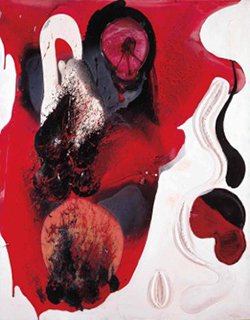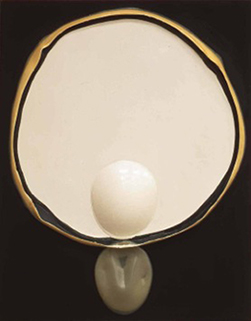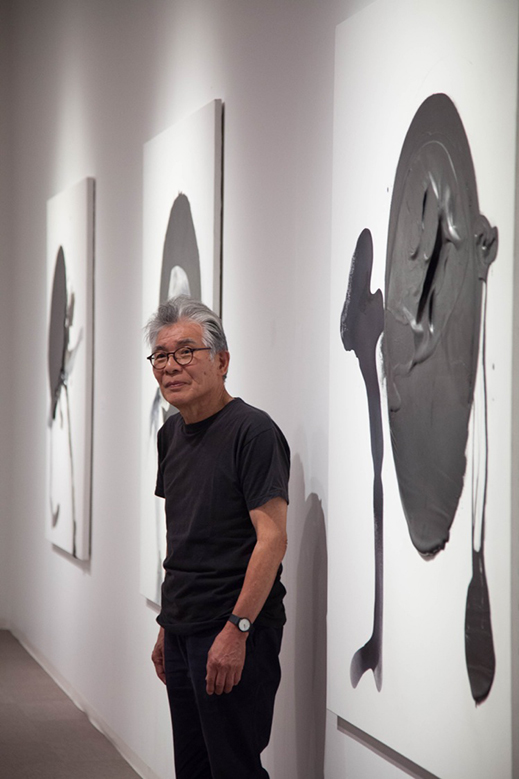 |
Focus features two in-depth reviews each month of fine art, architecture and design exhibitions and events at art museums, galleries and alternative spaces around Japan. The contributors are non-Japanese art critics living in Japan. |
|
|
 |
 |
 |
Black Is the Color: The Matsutani Currents Exhibition
Christopher Stephens |
 |
Exhibition view at the Otani Memorial Art Museum (photo by Kirico). |
After over six decades of obscurity in Japan, the Gutai Art Association has finally captured the public imagination. But it is not the art that is attracting attention, it is the prices that the group's works are now commanding, most notably those of Kazuo Shiraga (1924-2008). His abstract pictures, many of which were painted with his feet, have recently sold for as much as US$2.5 million (up from a mere $200,000 five years ago). The real story, however, is that the spirit of Gutai did not die with the group's leader, Jiro Yoshihara, in 1972. It lives on in the work of former members like Sadaharu Horio (b. 1939), who remains incessantly active, staging dozens of events and exhibitions around the world every year, and Takesada Matsutani (b. 1937), who has been based in Paris since 1966, and now more than ever is creating vibrant, wholly original art. This is immediately apparent from Matsutani Currents, an exhibition focusing primarily on the artist's latest work but also on some of his past efforts, now at the Otani Memorial Art Museum in Nishinomiya (Hyogo Prefecture), where the Osaka-born artist's family moved in 1952.
|
 |
|
|
|
Takesada Matsutani, Work '65 (1965), Hyogo Prefectural Museum of Art Collection. |
Joining Gutai in 1963, Matsutani was one of the group's "second generation" of artists. The first generation, mostly born in the 1920s, assembled around the painter Jiro Yoshihara (1905-72), an established figure from the previous generation, to form the pioneering avant-garde group in Ashiya in 1954. Yoshihara constantly exhorted his disciples to do things that had never been done and to avoid imitating anyone at all costs. This inspired the artists to express themselves with physical actions, such as breaking through sheets of paper and wrestling with mud, long before the term "performance art" was coined. They also experimented with materials, such as vinyl, electric lights, and explosives, that were not usually associated with art. And they adopted methods, such as smashing bottles of paint on the canvas and making "automatic" pictures with mechanical cars, that shifted the creative act from conscious intention to random occurrence.
Always aware of the importance of staying current, Yoshihara was constantly on the lookout for promising young artists. He first met Matsutani in the late '50s and invited him to join Gutai in 1963. Later the same year Matsutani held a solo exhibition at the Gutai Pinacotheca, the group's museum, which was housed in a repurposed warehouse in Osaka. In 1966, independent of his work with Gutai, Matsutani won grand prize in the First Mainichi Art Competition and a French government scholarship to study in Paris. He has lived there ever since.
 |
|
 |
|
|
|
Takesada Matsutani, Wave 91-1-8 (1991), Otani Memorial Art Museum Collection. |
|
Takesada Matsutani, White Circle (1966), Miyagi Museum of Art Collection. |
Matsutani's trademark material is vinyl adhesive, which he began using in the early '60s. His early experiments involved dripping the glue or allowing it to run down the canvas, where it hardened into shapes that he likened to "stalactites" or "cow udders." He also used his breath, electric fans, and hair dryers to create bulging membranes. Some works center on huge round protrusions that stretch across the entire picture plane, while others contain a series of plate-sized circles with mouth-like gashes, revealing a rough vinyl surface inside. These ovals and orifices are immediately suggestive of eggs and wombs, inviting us to enter a cell or return to an embryonic stage of life.
Since the late '70s, Matsutani has explored the rich range of blacks in a series called Stream, made with graphite pencil on paper and sometimes including a ridge or undulation of vinyl adhesive. What from a distance appears to be pitch dark becomes a textured field of pencil strokes recalling rivulets or wood grains when viewed up close, and a lustrous flow of black currents slightly farther away. In these works, the color exudes an uncharacteristic warmth, enveloping the viewer and erasing any hint of bleakness.
 |
|
Matsutani in front of his work at the Otani, October 2015 (photo by Kirico). |
Matsutani's performances are a model of cool reserve and effortlessness. Rather than forcing his materials to do things they normally would not, he frees them to do what comes naturally. In the center of the wall at one end of a long gallery at the Otani, Matsutani installed a long L-shaped strip of canvas covered in black sumi ink that stretched down from the ceiling and continued across the floor for approximately the same length. In the middle was a square white canvas enclosed in a frame, and hanging over it a cloth sack suspended from a pulley. Casually taking hold of the beige sack, Matsutani pierced the bottom with a needle and set it down gently on the canvas. Drops of black ink trickled across the white surface, and before the viewer could fully comprehend what had happened, the performance was over. Matsutani's simple act perfectly embodies Jiro Yoshihara's declaration that in Gutai art, the human spirit never absorbs or overpowers the material: the two opposing forces reach out and join with each other.
All images provided by the Otani Memorial Art Museum, Nishinomiya City.
|
 |
 |
Christopher Stephens
Christopher Stephens has lived in the Kansai region for over 25 years. In addition to appearing in numerous catalogues for museums and art events throughout Japan, his translations on art and architecture have accompanied exhibitions in Spain, Germany, Switzerland, Italy, Belgium, South Korea, and the U.S. His recent published work includes From Postwar to Postmodern: Art in Japan 1945-1989: Primary Documents (MoMA Primary Documents, 2012) and Gutai: Splendid Playground (Solomon R. Guggenheim Museum, 2013). |
|
 |
|